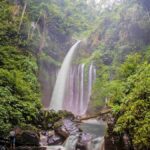

Climbing Mount Rinjani, Indonesia’s second-highest volcano, is an adventure of a lifetime filled with breathtaking views, diverse landscapes, and a sense of accomplishment. However, to ensure a safe and enjoyable trek, it is crucial to pack wisely. In this guide, we’ll help you understand what you should bring when climbing Mount Rinjani.
– Sturdy Hiking Boots: A good pair of waterproof, ankle-supporting hiking boots is essential. Look for shoes with a strong grip to handle rocky and uneven terrain.
– Trekking Poles: These can provide extra support and stability, especially during steep ascents and descents.
– Comfortable Clothing: Dress in moisture-wicking, lightweight, and breathable fabrics. Layering is key, so bring:
– Base layer (long-sleeve shirt and long pants)
– Insulating layer (fleece or down jacket)
– Waterproof and windproof outer layer (jacket and pants)
– Daypack (20-30 liters): A lightweight daypack is ideal for carrying your essentials during the trek.
– Water Reservoir or Bottles: Stay hydrated! Bring at least 2-3 liters of water capacity. A hydration bladder can be convenient for sipping on-the-go.
– Snacks: Pack high-energy snacks such as trail mix, energy bars, or dried fruits to keep your energy levels up during the hike.
If you’re planning a multi-day trek, you’ll need to consider camping gear:
– Sleeping Bag: A warm sleeping bag rated for cold temperatures, as it can get quite chilly at night.
– Tent: Lightweight and durable, if not provided by your trekking company.
– Sleeping Mat: For added comfort while sleeping on the ground.
– First Aid Kit: A small kit with essentials such as band-aids, antiseptic wipes, pain relievers, and any personal medications.
– Headlamp or Flashlight: Essential for nighttime navigation and camp use. Don’t forget extra batteries.
– Sunscreen and Lip Balm: Protect your skin from the harsh sun, especially at higher altitudes.
– Insect Repellent: Useful for warding off mosquitoes and other insects.
– Map and Compass: Even if you’re with a guide, it’s good to have your own navigation tools.
– Emergency Whistle: For signaling in case of an emergency.
– Multi-tool or Swiss Army Knife: Handy for various situations that may arise during the trek.
– Warm Hat and Gloves: Essential for keeping warm during colder evenings and at higher elevations.
– Sunglasses: Protect your eyes from the sun’s glare, especially at higher altitudes.
– Gaiters: These can help keep dirt and debris out of your boots during the hike.
– Electrolyte Tablets: To replenish lost salts and minerals during the trek.
– Lightweight Cooking Gear: If you’re going self-catering, consider portable cooking options, although most trekking packages provide meals.
– Biodegradable Trash Bags: Carry out all your waste to help preserve the beauty of Mount Rinjani. Leave no trace!
Climbing Mount Rinjani is an unforgettable experience, but preparation is key to ensuring your trek is enjoyable and safe. By packing the right gear and essentials, you’ll be well-equipped to handle the challenges of this stunning adventure. Remember to check the weather forecast and adjust your packing list accordingly.
If you book a Rinjani tour package with us all camping equipments, food and drink we will prepare for you included in the package price.
Ready to embark on your journey? Start planning and packing today for an incredible adventure on Mount Rinjani! If you have any further questions or need assistance with your trek, feel free to contact us for expert guidance and support. Happy trekking!

Rinjani Tour is a premier Rinjani trekking tours company with decades of combined experience on the mountain. We specialize in hiking Mount Rinjani and Lombok Island tours. We run our own tour operations, staffed with expert mountain guides and tour operators.
rinjanitour.id@gmail.com
+62 81973204404
+62 81973204404
Copyright ©2025 Rinjani Tour Company. All Rights Reserved
